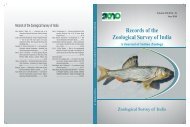Endemic Fauna of Andaman and Nicobar Islands Bay of Bengal
Endemic Fauna of Andaman and Nicobar Islands Bay of Bengal
Endemic Fauna of Andaman and Nicobar Islands Bay of Bengal
You also want an ePaper? Increase the reach of your titles
YUMPU automatically turns print PDFs into web optimized ePapers that Google loves.
level. Quite a few lists <strong>of</strong> endemic species <strong>of</strong> the isl<strong>and</strong>s on various groups are made available (Tikader<br />
<strong>and</strong> Das, 1985; Chakraborty, 1997; Agarwal, 1998; M<strong>and</strong>al <strong>and</strong> Chakraborthy, 1999; Alfred <strong>and</strong><br />
Chakraborty, 2002 <strong>and</strong> Jayaraj <strong>and</strong> Andrews, 2005). Subsequently many species <strong>and</strong> subspecies<br />
considered as endemics have been shifted to non-endemics <strong>and</strong> many new species have been added.<br />
By summing up <strong>of</strong> all the available literature records, an updated list <strong>of</strong> endemics <strong>of</strong> the isl<strong>and</strong>s has<br />
been prepared. About 1117 species <strong>and</strong> subspecies <strong>of</strong> animals <strong>of</strong> major groups, both vertebrate <strong>and</strong><br />
invertebrates, inhabiting terrestrial, freshwater <strong>and</strong> marine habitats considered endemic to the<br />
<strong>Andaman</strong> <strong>and</strong> <strong>Nicobar</strong> Isl<strong>and</strong>s is presented here. For the higher vertebrate groups viz. mammals,<br />
birds, reptiles, amphibians <strong>and</strong> fish common name, diagnostic features, habitat, distribution <strong>and</strong><br />
current status is given. Where as for other groups like molluscs, crustaceans, mei<strong>of</strong>aunal elements,<br />
insects, etc. only their habitat, distribution <strong>and</strong> current staus is given as these small organisms can not<br />
be identified to species level by the common man or an amature in the field. The literature cited in<br />
the text is given at the end.<br />
Physiography <strong>of</strong> the isl<strong>and</strong>s<br />
The <strong>Andaman</strong> <strong>and</strong> <strong>Nicobar</strong> Archipelago comprises several hundred isl<strong>and</strong>s were once part <strong>of</strong><br />
the Asian main l<strong>and</strong> but got separated over 100 million years ago during the Upper Mesozoic Period.<br />
The archipelago can be broadly divided into two groups, namely the <strong>Andaman</strong>s <strong>and</strong> the <strong>Nicobar</strong>s<br />
separated by the Ten-degree Channel which is about 150 km wide <strong>and</strong> 400 fathoms deep. The main<br />
part <strong>of</strong> <strong>Andaman</strong> Group is collectively called as the Great <strong>Andaman</strong>s comprising five adjoining isl<strong>and</strong>s,<br />
viz. North <strong>Andaman</strong>, Middle <strong>Andaman</strong>, South <strong>Andaman</strong>, Baratang <strong>and</strong> Rutl<strong>and</strong> isl<strong>and</strong>s. All these isl<strong>and</strong><br />
masses are separated by narrow channels. The southern most <strong>of</strong> the isl<strong>and</strong> group is Little <strong>Andaman</strong><br />
which is separated by a straight called Ducnan Passage. The <strong>Nicobar</strong> group comprises <strong>of</strong> about 24<br />
isl<strong>and</strong>s with a total l<strong>and</strong> mass <strong>of</strong> about 1,841 sq km. The northern most point <strong>of</strong> the group is Car<br />
<strong>Nicobar</strong> Isl<strong>and</strong> <strong>and</strong> the southern most is Indira Point or Pigmilion Point <strong>of</strong> the Great <strong>Nicobar</strong> Isl<strong>and</strong>. Of<br />
all the isl<strong>and</strong>s <strong>of</strong> <strong>Nicobar</strong> Group, Great <strong>Nicobar</strong> isl<strong>and</strong> is the largest having an area <strong>of</strong> 1,045 sq.km. The<br />
other major isl<strong>and</strong>s <strong>of</strong> the group are Car <strong>Nicobar</strong>, Chowra, Tillanchong, Teressa, Bompoka, Camorta,<br />
Trinket, Nancowry, Katchal, Pulomilo, Kondul <strong>and</strong> Little <strong>Nicobar</strong>. All the isl<strong>and</strong>s <strong>of</strong> the archipelago are<br />
fertile <strong>and</strong> support evergreen vegetation. The present configuration achieved by these isl<strong>and</strong>s only<br />
about 26 million years ago. The two isl<strong>and</strong>s, Narcondam <strong>and</strong> Barren are <strong>of</strong> volcanic origin. The<br />
Narcondam was totally dormant <strong>and</strong> extinct for quite long period, shown the signs <strong>of</strong> eruption during<br />
the mega earth quake took place on 26 th December 2004 <strong>and</strong> the Brren Isl<strong>and</strong> is highly active <strong>and</strong><br />
frequently erupting. The soil cover is more or less thin varying between two to five meters in the hill<br />
tracts. The coastal flats are admixture <strong>of</strong> silty clay, s<strong>and</strong> <strong>and</strong> fragments <strong>of</strong> coral lime. The soil is<br />
moderately acidic with high humus on top layer. The climate is <strong>of</strong> tropical nature. Due to proximity <strong>of</strong><br />
2
















